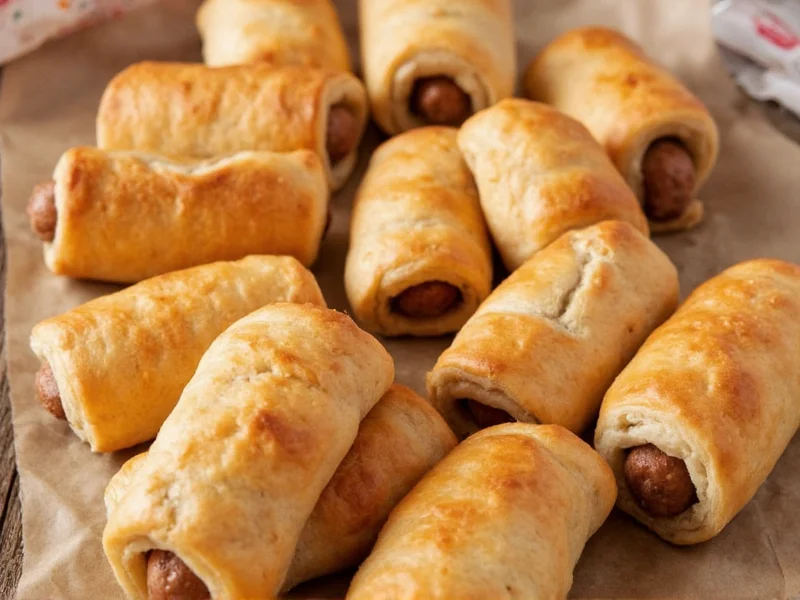Transforming ordinary sausages into golden, flaky sausage rolls is simpler than you might think. This approach solves the common problem of not having sausage meat on hand while delivering that classic British pub snack with minimal effort. Whether you're preparing for a party, weekend treat, or quick family meal, this technique produces consistently impressive results that rival bakery versions.
Why Use Whole Sausages for Sausage Rolls
Using pre-made sausages offers several advantages over loose sausage meat. Most quality sausages already contain the perfect meat-to-fat ratio and seasoning blend that creates juicy, flavorful filling. You'll avoid the mess of handling raw meat while ensuring consistent quality. This method works particularly well with higher-quality sausages that contain at least 70% meat content and minimal fillers.
Essential Ingredients for Sausage Rolls from Sausages
The beauty of this recipe lies in its simplicity. You only need three core components, though optional additions can enhance flavor:
| Ingredient | Quantity | Notes |
|---|---|---|
| Quality sausages | 8-10 links | Pork, chicken, or vegetarian; 70%+ meat content |
| Frozen puff pastry | 1 sheet (about 320g) | Thawed according to package instructions |
| Egg | 1 | For egg wash (optional but recommended) |
| Milk or water | 1 tbsp | Mixed with egg for wash |
Step-by-Step Preparation Guide
1. Prepare the Sausages
Carefully slice lengthwise along each sausage casing using a sharp knife. Gently peel back and remove the entire casing membrane. This step requires patience—work slowly to avoid tearing the meat. For best results, chill sausages for 20 minutes before handling, as cold meat holds its shape better. This technique for making sausage rolls using regular sausages preserves the meat's integrity while removing the casing cleanly.
2. Roll Out the Pastry
On a lightly floured surface, roll your thawed puff pastry into a rectangle approximately 12x16 inches. Aim for even thickness of about 1/8 inch. If your pastry tears, patch it with small pieces—these will bake invisible. Professional bakers recommend keeping pastry cold during handling to ensure maximum rise and flakiness when baking sausage rolls from sausages.
3. Shape the Filling
Divide your de-cased sausage meat into eight equal portions. Roll each portion into a log slightly shorter than your pastry width. Place these logs horizontally across the pastry sheet, leaving 2 inches of space at the top and bottom edges. For authentic British sausage rolls recipe results, arrange logs with about 1 inch between them.
4. Wrap and Seal
Fold the top pastry edge over the sausages, then fold the bottom edge up to meet it. Press the seam gently with your fingers to seal. Using a sharp knife, cut between each sausage roll to separate them. For that professional finish, crimp the edges with a fork. This method for sausage rolls from sausages creates perfectly portioned individual rolls every time.
5. Vent and Glaze
Make three small diagonal slashes across the top of each roll to allow steam to escape during baking. Whisk together the egg and milk, then brush this wash over the entire surface of the pastry. This creates that signature golden-brown finish. For extra flavor, sprinkle with sesame seeds or poppy seeds before baking.
6. Bake to Perfection
Chill the assembled rolls in the refrigerator for 15-20 minutes—this prevents pastry shrinkage. Preheat oven to 200°C (400°F). Bake for 20-25 minutes until the pastry is puffed and golden, and the sausage meat reaches 71°C (160°F) internally. Rotate the baking tray halfway through for even browning. This baking time for homemade sausage rolls ensures crisp pastry without drying the filling.
Troubleshooting Common Issues
Soggy Bottoms: Place rolls on a preheated baking sheet or use a silicone mat instead of parchment paper. The initial heat blast helps set the pastry quickly.
Leaking Filling: Ensure you've removed all sausage casing fragments, as these can create weak points. Don't overfill—leave adequate pastry around each sausage.
Pastry Shrinking: Always chill assembled rolls before baking. This relaxes the gluten and prevents shrinkage during the initial oven spring.
Flavor Variations to Try
Once you've mastered the basic technique for making sausage rolls with regular sausages, experiment with these popular variations:
- Cheese-Stuffed: Insert a thin cheddar stick down the center of each sausage before wrapping
- Herb-Infused: Mix chopped fresh sage, thyme, and parsley into the sausage meat
- Spicy Kick: Add a pinch of cayenne or smoked paprika to the meat mixture
- Apple & Sage: Finely dice 1/4 apple per sausage and mix with fresh sage
Storage and Reheating Instructions
Properly stored sausage rolls maintain quality for up to 3 days. Cool completely on a wire rack, then store in an airtight container with parchment between layers. For longer storage, freeze unglazed rolls on a baking sheet, then transfer to freezer bags for up to 3 months. When reheating homemade sausage rolls, use an oven or air fryer at 180°C (350°F) for 8-10 minutes—this preserves crispness better than microwaving.
Why This Method Works Better Than You'd Expect
The secret behind successful sausage rolls from sausages lies in the sausage formulation itself. Quality sausages contain binders like breadcrumbs and seasonings already optimized for texture and flavor. When you remove the casing, you're essentially working with pre-seasoned, perfectly textured sausage meat that requires no additional preparation. This approach for easy sausage rolls from sausages without casing eliminates guesswork while delivering consistent, professional-quality results.











 浙公网安备
33010002000092号
浙公网安备
33010002000092号 浙B2-20120091-4
浙B2-20120091-4